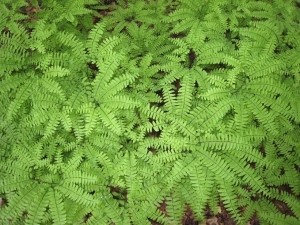Indicator plants are peculiar to a certain place. Though they aren’t necessarily rare, they don’t grow just anywhere. They tolerate only a narrow range of growing conditions, so their presence in a forest signals some distinctive aspect of that place. Not all plants are so uniquely characteristic of specific conditions. Really, most aren’t. In the dizzying complexity and variation that is a forest, knowing which plants reliably indicate something meaningful – and which are but leafy red herrings – can be highly useful.
Foresters gravitate toward the useful, and we’ve long made good use of indicator plants. These plants help us understand other features of a forest that may otherwise be imperceptible during a woodland assessment. For example, soil types are profoundly important in forestry, and yet they’re hard to see buried beneath a layer of leaf-litter. Rather than drag a shovel through the woods, a forester learns to associate certain plants with certain soil types. We keep an eye out for indicator species that only show up when we’re walking through certain specific sites.
All communities of plants reflect their underlying soils, geology, and hydrology. But many natural communities and most tree species are capable of growing across a wide range of soil and moisture regimes. That’s why the most reliable indicators tend to be herbaceous, understory species – typically a fern or wildflower – that are highly dependent on a particular site type. These plants have evolved good competitive abilities that suit them for the narrowly defined site conditions, where they tend to be. And they have developed virtually no competitive ability in the places that lack those conditions, where they tend not to be.
Maidenhair fern is an excellent example. Not just visually beautiful, it also reliably indicates the presence of fertile, moist, but well-drained loams – the kind of soils that grow the sugar maples of dreams. So when you’re done looking down in admiration at those delicate fronds, you can expect to look up and see tall, vigorous maples towering above those fair maidenhairs. They’re such good indicator plants, you almost don’t have to look up. And even if there are no corker maples above, seeing those ferns tells you that there could be.
Remember, it doesn’t necessarily work the other way. If the indicator plant is not present, it doesn’t necessarily mean that the associated site characteristic is lacking. In this example, a site lacking maidenhair fern will not necessarily lack good soils for sugar maple. The key is when this fern is present, it’s a good bet that sugar maples will also grow well there, possibly in company with other rich soil indicators, such as bloodroot and wild ginger. If, however, the site in question is lacking maidenhairs and maples, and is instead growing bracken fern – an indicator of dry, relatively infertile soil – you’d probably be better off giving up your maple dreams and concentrating on growing oak instead.
Indicator plants have thus commonly been used in forestry to compare site quality, which can inform a forester’s management strategies – from silvicultural prescriptions and choices of species to favor to season for logging and skid trail location. But indicator plants may also be used to tell us other things – beyond site quality – about an environment. Many plants are used to indicate air pollution, for example, and because some plants are so specifically linked to certain minerals and metals, the term “botanical prospecting” is applied to the practice of using them to locate valuable ore deposits.
So, the utility of indicator plants does not end, and didn’t begin, with foresters or even the ecologists who study and document correlations between indicator species and their environments. Indeed, all kinds of old timers and natives have forever had reason to use plants or other information to tell them where something else is, be it a certain elevation and exposure that could mean a bounty of birch bark for a box-crafter, or a mat of needles that might produce a skillet full of mushrooms for a cook.
But you don’t have to be old or native to learn to recognize key plants or features that indicate something of valuable interest to you. You probably do it all the time, using subtle landscape clues to interpret what’s going on in your woods. And because there is a lot going on out there, we can all learn more. Personally, I’d like to know the plants that reliably indicate where I might find a big buck in November.



Discussion *